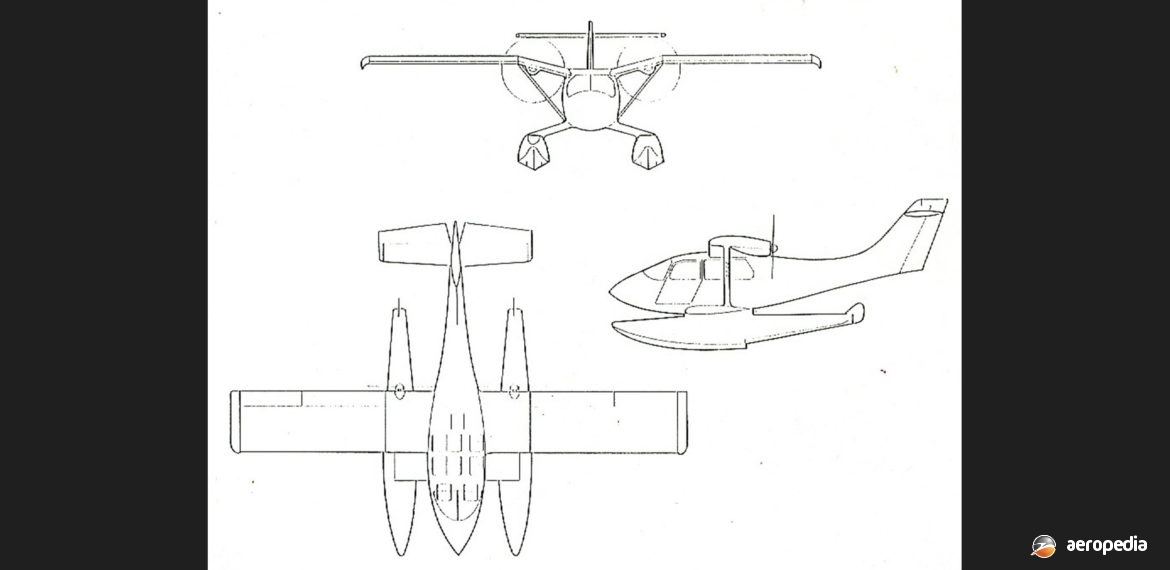Photograph:
Three-view drawing of the Seair project (Seair Pacific)
Country of origin:
Australia
Description:
Twin-engine commercial utility amphibian
Power Plant:
Two 224 kw (300 hp) Continental IO-550 six-cylinder horizontally-opposed air-cooled engines
Specifications:
- [Estimated]
- Wingspan: 14.6 m (48 ft)
- Length: 10.6 m (34 ft 8 in)
- Max level speed: 278 km/h (173 mph)
- Cruising speed at 1,524 m (5,000 ft) at 78% power: 278 km/h (173 mph)
- Stalling speed: 117 km/h (73 mph)
- Endurance: 6 hours
- Empty weight: 1,259 kg (2,776 lb)
- Loaded weight: 3,325 kg (7,330 lb)
History:
Seair Pacific Pty Ltd of Airlie Beach, QLD was set up in the mid-1980s to build a full-size prototype of an eight-passenger commercial seaplane powered by two engines in the pusher configuration. Initial design work was to be completed by 1990 and the Company hoped to have a prototype completed and flying by 1991, the manufacturer stating it had a requirement of its own for 20 aircraft. The Company, with managing director, Shane O’Hare, was a merger of two Australian seaplane operators in Queensland, Air Whitsunday and Seair Pacific. It was stated the two operators joined forces in 1988 to meet the growing demands of the tourist industry around the Great Barrier Reef, and to pool technical expertise in the specialised field of seaplane services.
It was announced the Company, known as Seair Pacific, would be one of the largest seaplane operators in the world, with a fleet of 17 aircraft. It was stated at the time the new aircraft would be a revolutionary eight-passenger amphibious aircraft which would be manufactured in Australia, a feasibility study then being underway. It was also stated 21 full-time pilots would be employed, with employment being given to more than 50 staff.
Air Whitsunday had twice won the Queensland State tourism award in the transport category and was established at Airlie Beach in the 1970s. Seair Pacific commenced operations at Southport shortly thereafter, both companies being involved in the tourist industry in Queensland along the Great Barrier Reef. The Chief Pilot of Seair announced the Company was heavily involved in research and development of a new seaplane capable of “comfortably transporting eight passengers.” The aircraft became known as “Project Seair” and was designed by Gold Coast engineer, Richard Hart, he indicating it would have an all-metal mainspar but the fuselage would be manufactured from glass composite materials.
The aircraft was to have an NASA design high-wing, gull-wing configuration, with either two Lycoming IO-520 engines with fully reversible propellers, or two Continental IO-550 engines. The engines were to be mounted above the wings and the twin floats were to be strutless, being attached to the fuselage by two Kevlar sponsons that would be of aerodynamic design to enhance lift and reduce drag. The aircraft was to comply with twin IFR performance requirements and was expected to cruise at 278 km/h (173 mph) at 1,524 m (5,000 ft) with engines at 78 per cent power. The aircraft would have a crew of two .
In 1988 the Company announced Project Seair should be completed within three years and it was hopeful the prototype would be completed at that time. It also stated there was a potential overseas market for a seaplane meeting the specifications announced and that in Canada alone there were 7,500 seaplanes which were 20 to 30 years old and would need replacement. An expected price tag in 1988 prices was $600,000 to $800,000.
In mid-1988 it was stated an aeronautical engineer had been working on the project for 15 months and preliminary studies indicated 30 aircraft would have to be completed for the project to break even. The Company was hoping to get the aircraft into production as soon as possible but in mid-1988 was still considering where the production facility would be, but expected it to be on the Gold Coast, QLD or at Ballina, NSW. In the event it seems the attempt by the company to raise money to launch the project failed and this very promising Australian project did not get off the ground.

